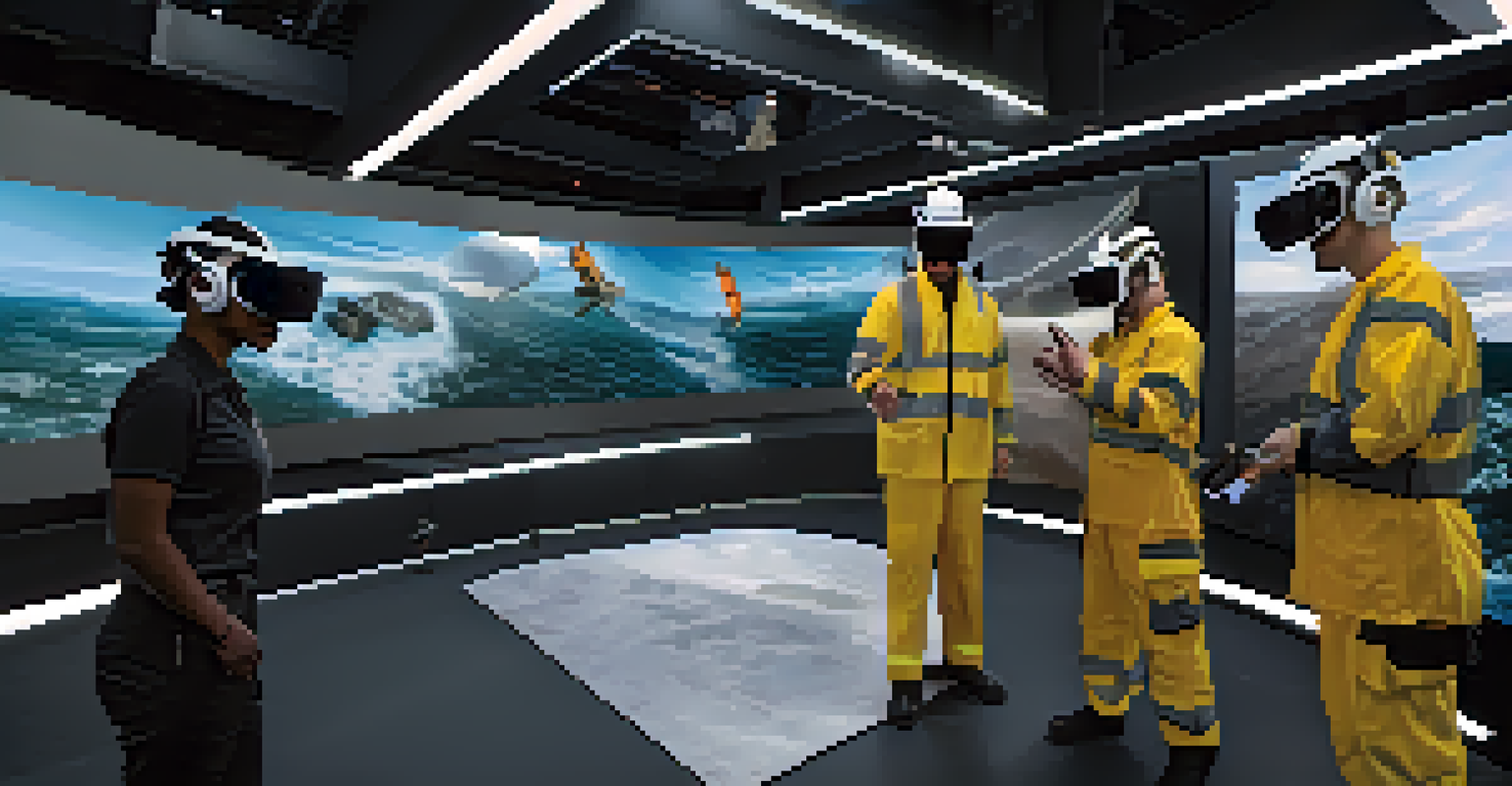Microlearning for Crisis Management Training

Understanding Microlearning in Crisis Management
Microlearning refers to bite-sized, focused learning modules designed to enhance retention and engagement. In the context of crisis management, this approach is particularly beneficial, as it allows employees to quickly absorb crucial information without feeling overwhelmed. Imagine learning to handle a crisis in the same way you'd learn a new recipe—step by step, with clear instructions.
Microlearning is the key to unlocking just-in-time training, enabling individuals to respond effectively in high-pressure situations.
This method caters to the fast-paced environment often associated with crises, where quick decision-making is vital. Instead of lengthy training sessions that can lead to cognitive overload, microlearning provides just-in-time knowledge that employees can access on-demand. It’s like having a first-aid manual readily available when needed, ensuring that the information is fresh and relevant.
Moreover, microlearning modules can be easily updated to reflect new protocols or procedures, ensuring that everyone is on the same page. This adaptability is crucial in crisis situations, where new challenges can arise unexpectedly. By incorporating microlearning into crisis management training, organizations can foster a more agile and responsive workforce.
Key Benefits of Microlearning for Crisis Training
One of the standout benefits of microlearning is its ability to enhance retention rates. Studies show that people remember information better when it’s presented in small, manageable chunks rather than lengthy sessions. Think of it like trying to remember a long shopping list—it's much easier to recall a few items at a time than to memorize the entire list at once.

Additionally, microlearning encourages continuous learning, allowing employees to revisit materials as needed. This is particularly crucial in crisis management, where keeping skills sharp can make a significant difference. Just as athletes review their plays, employees can refresh their knowledge anytime, ensuring they’re always prepared for the unexpected.
Microlearning Enhances Crisis Training
By breaking down information into bite-sized modules, microlearning improves knowledge retention and engagement during crisis management training.
Furthermore, microlearning can be easily integrated into existing training programs. Organizations can create short videos, infographics, or quizzes that align with their specific crisis management protocols. This flexibility not only saves time but also keeps the training engaging and relevant.
Designing Effective Microlearning Modules
Creating impactful microlearning modules for crisis management requires thoughtful design and clear objectives. Start by identifying the core skills and knowledge employees need to navigate potential crises effectively. This might include communication strategies, decision-making frameworks, or safety protocols—essentially the tools they need in their crisis toolbox.
In an era where information is at our fingertips, the ability to learn quickly becomes a vital skill, especially in crisis management.
Next, focus on making the content engaging and interactive. Use real-world scenarios to illustrate concepts, as this helps learners visualize how to apply their knowledge. For instance, consider role-playing exercises or simulations that mimic actual crisis situations, allowing employees to practice their responses in a safe environment.
Finally, ensure that each module is easily accessible and user-friendly. A mobile-friendly platform can allow employees to learn on-the-go, fitting training into their busy schedules. Just as you’d prefer a quick, accessible recipe over a complicated cookbook, employees will appreciate training that fits seamlessly into their lives.
Utilizing Technology in Microlearning
Technology plays a pivotal role in facilitating microlearning for crisis management training. Learning management systems (LMS) and mobile apps provide platforms where organizations can host and distribute microlearning content efficiently. These tools enable employees to access training materials anytime, anywhere, which is particularly valuable during a crisis when timely information is essential.
Furthermore, technology can enhance the interactivity of microlearning modules. Features like quizzes, interactive videos, and gamified elements can make learning more engaging and fun. This not only keeps employees interested but also encourages them to complete their training, much like a game that motivates players to reach the next level.
Flexible and Accessible Learning
Microlearning allows for on-demand access to training materials, making it easier for employees to refresh their skills and knowledge as needed.
Lastly, analytics tools integrated within these platforms can provide valuable insights into learner progress and engagement. Organizations can track which modules are accessed most frequently and where employees may be struggling. This data can inform future training strategies, ensuring that the content remains effective and aligned with the organization’s crisis management needs.
Overcoming Challenges in Microlearning Implementation
While microlearning offers numerous benefits, implementing it effectively can present challenges. One common hurdle is resistance to change, as employees may be accustomed to traditional training methods. It’s essential to communicate the advantages of microlearning clearly and demonstrate how it can improve their crisis management skills without adding to their workload.
Another challenge is ensuring content quality and relevance. Organizations must invest time in developing high-quality modules that provide real value. Collaborating with subject matter experts can help in crafting content that is not only informative but also practical and applicable to real-life scenarios.
Lastly, organizations must address the technology gap among employees. Not everyone may be comfortable using new digital tools, so providing training on how to navigate these platforms is crucial. Just as learning to use a new smartphone can be daunting, offering support can ease the transition and encourage employee buy-in.
Measuring Success of Microlearning in Crisis Training
Measuring the effectiveness of microlearning in crisis management training is crucial for continuous improvement. Organizations can assess success through various metrics, such as completion rates, quiz scores, and employee feedback. These indicators provide insights into how well the training is being received and whether it’s meeting its objectives.
Additionally, conducting regular evaluations and simulations can help gauge employees' confidence and competence in crisis situations. For instance, after completing a microlearning module, a follow-up simulation can reveal how well employees apply their newly acquired knowledge. This practical application reinforces learning and highlights areas for further development.
Technology Boosts Learning Engagement
Utilizing technology, such as LMS and interactive tools, makes microlearning more engaging and helps organizations track employee progress effectively.
Moreover, gathering anecdotal evidence from employees can provide valuable qualitative insights. Encouraging open discussions about the training experience allows for feedback on what works well and what could be improved. Much like a team debrief after a game, these conversations can foster a culture of continuous learning and adaptation.
The Future of Microlearning in Crisis Management Training
As organizations continue to navigate the complexities of crisis management, the role of microlearning is expected to grow. With advancements in technology, we can anticipate even more innovative ways to deliver training that is engaging and effective. Virtual reality (VR) and augmented reality (AR) could soon be used to create immersive learning experiences that simulate real-life crises, offering employees a safe space to practice their responses.
Moreover, the increasing demand for remote work training means that microlearning will play a crucial role in ensuring all employees have access to essential resources. As organizations become more distributed, having a flexible, accessible training format becomes even more important. Microlearning can bridge the gap, providing consistent training regardless of location.

In conclusion, microlearning is not just a trend; it’s a strategic approach to crisis management training that can enhance preparedness and response. By embracing this method, organizations can foster a culture of continuous learning and resilience, ensuring their workforce is equipped to face any challenge that arises.